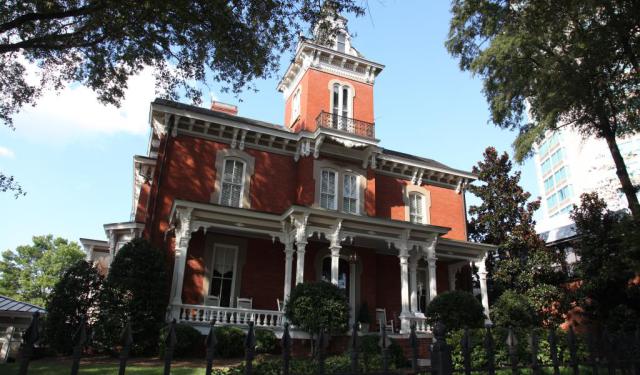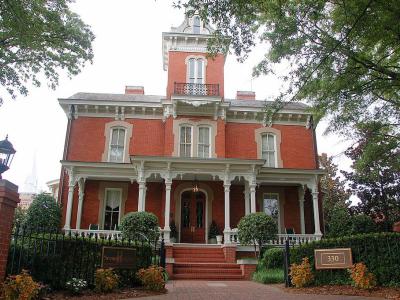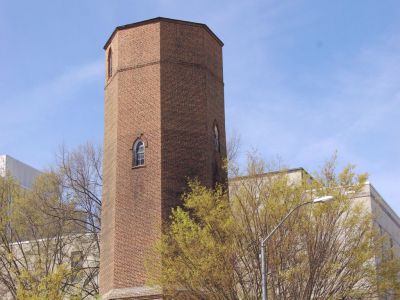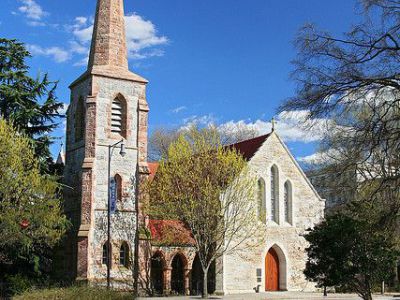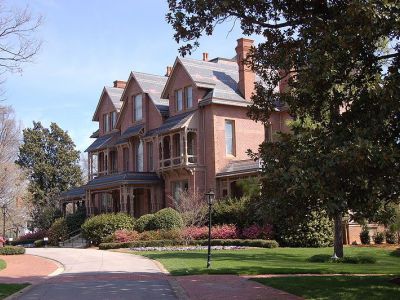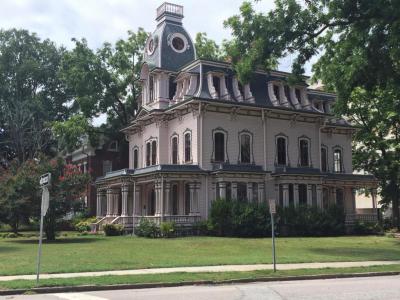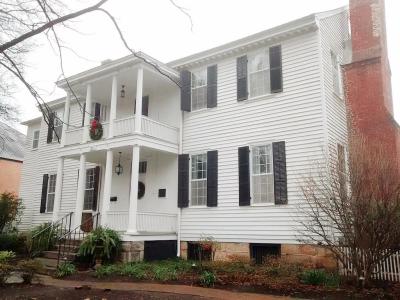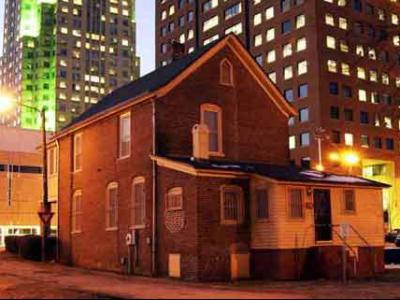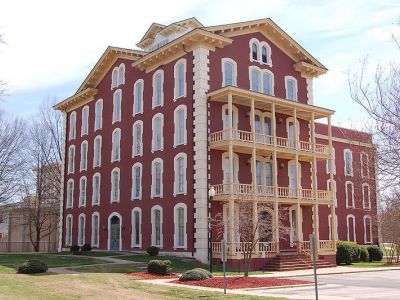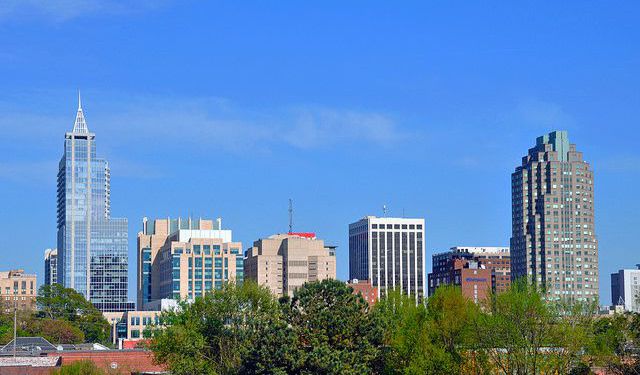Historic Buildings Walking Tour (Self Guided), Raleigh
As you traverse the streets of North Carolina's capital Raleigh, you cannot help noticing a wealth of historic buildings, each illustrating a chapter in the city's annals.
Among these revered structures, the Joel Lane House emerges as a cherished relic of the distant past; its venerable walls echo with the whispers of bygone eras. The Dodd-Hinsdale House, a stately emblem of neoclassical elegance, exudes an aura of dignified grandeur.
Towering above the cityscape, the Raleigh Water Tower rises as an iconic sentinel. Its industrial grace is a poignant reminder of the confluence of functionality and aesthetics that characterized an era of visionary urban planning.
A few blocks away, the Christ Episcopal Church's spire pierces the sky, a soaring embodiment of spiritual devotion etched into Raleigh's architectural tableau.
Gazing upon the North Carolina Executive Mansion, one is transported into the heart of governance and power. Meanwhile, the Heck-Andrews House, a showcase of Victorian sumptuousness, stands as a living reverie of the opulent past; its meticulously preserved interiors serve as a portal into the lives of yesteryears' elite.
The tranquility of Haywood Hallhouse and Gardens, where the past blooms anew, offers a respite from the urban bustle, while the Pope House Museum to African American history and heritage, resonates with the indomitable spirit of advocacy and change.
Finally, Estey Hall, with its dignified academic countenance, is an emblem of intellectual pursuit, embracing the call of history and knowledge.
Together, these resplendent structures compose an eloquent narrative of Raleigh's evolution-a timeless saga etched in stone, forging connections with the generations that came before us. Whether you're a resident or a visitor, let these historic treasures inspire you to uncover the layers of Raleigh's past and delve deeper into the ongoing story of this vibrant city.
Among these revered structures, the Joel Lane House emerges as a cherished relic of the distant past; its venerable walls echo with the whispers of bygone eras. The Dodd-Hinsdale House, a stately emblem of neoclassical elegance, exudes an aura of dignified grandeur.
Towering above the cityscape, the Raleigh Water Tower rises as an iconic sentinel. Its industrial grace is a poignant reminder of the confluence of functionality and aesthetics that characterized an era of visionary urban planning.
A few blocks away, the Christ Episcopal Church's spire pierces the sky, a soaring embodiment of spiritual devotion etched into Raleigh's architectural tableau.
Gazing upon the North Carolina Executive Mansion, one is transported into the heart of governance and power. Meanwhile, the Heck-Andrews House, a showcase of Victorian sumptuousness, stands as a living reverie of the opulent past; its meticulously preserved interiors serve as a portal into the lives of yesteryears' elite.
The tranquility of Haywood Hallhouse and Gardens, where the past blooms anew, offers a respite from the urban bustle, while the Pope House Museum to African American history and heritage, resonates with the indomitable spirit of advocacy and change.
Finally, Estey Hall, with its dignified academic countenance, is an emblem of intellectual pursuit, embracing the call of history and knowledge.
Together, these resplendent structures compose an eloquent narrative of Raleigh's evolution-a timeless saga etched in stone, forging connections with the generations that came before us. Whether you're a resident or a visitor, let these historic treasures inspire you to uncover the layers of Raleigh's past and delve deeper into the ongoing story of this vibrant city.
How it works: Download the app "GPSmyCity: Walks in 1K+ Cities" from Apple App Store or Google Play Store to your mobile phone or tablet. The app turns your mobile device into a personal tour guide and its built-in GPS navigation functions guide you from one tour stop to next. The app works offline, so no data plan is needed when traveling abroad.
Historic Buildings Walking Tour Map
Guide Name: Historic Buildings Walking Tour
Guide Location: USA » Raleigh (See other walking tours in Raleigh)
Guide Type: Self-guided Walking Tour (Sightseeing)
# of Attractions: 9
Tour Duration: 2 Hour(s)
Travel Distance: 3.7 Km or 2.3 Miles
Author: karenv
Sight(s) Featured in This Guide:
Guide Location: USA » Raleigh (See other walking tours in Raleigh)
Guide Type: Self-guided Walking Tour (Sightseeing)
# of Attractions: 9
Tour Duration: 2 Hour(s)
Travel Distance: 3.7 Km or 2.3 Miles
Author: karenv
Sight(s) Featured in This Guide:
- Joel Lane House
- Dodd-Hinsdale House
- Raleigh Water Tower
- Christ Episcopal Church
- North Carolina Executive Mansion
- Heck-Andrews House
- Haywood Hallhouse and Gardens
- Pope House Museum
- Estey Hall
1) Joel Lane House
The Joel Lane House, also known as Wakefield, is a historic home and museum in Raleigh, North Carolina. Built in 1769, it is the oldest dwelling in Wake County and is named after Joel Lane, known as the "Father of Raleigh" and the "Father of Wake County." Lane played a crucial role in North Carolina's transition from a colony to a state and in establishing Raleigh as the capital. He owned significant amounts of land and held political influence.
Lane was an influential member of the colonial General Assembly and played a key role in the creation of Wake County in 1770. It is believed that the county's first court convened at Lane's home in 1771, where he served as a member until his death. During the Revolutionary War, Lane's property hosted important government meetings and served as a venue for the state General Assembly in 1781. He continued to have political influence after the war, serving in the state Senate and participating in the convention that ratified the United States Constitution.
One of Lane's notable contributions was his involvement in the decision to establish Raleigh as the permanent capital of North Carolina. In 1792, the legislature purchased 1,000 acres of Lane's land to create the city, and his house was located near its western boundary. After Lane's death, the house changed hands several times until it was acquired by the National Society of Colonial Dames of America in 1927, who operate it as a house museum today.
In 2019, the Joel Lane House celebrated its 250th anniversary, and a restoration effort was undertaken to remove layers of paint and repair damaged wood. The house was repainted to match its original color of garnet red.
Lane was an influential member of the colonial General Assembly and played a key role in the creation of Wake County in 1770. It is believed that the county's first court convened at Lane's home in 1771, where he served as a member until his death. During the Revolutionary War, Lane's property hosted important government meetings and served as a venue for the state General Assembly in 1781. He continued to have political influence after the war, serving in the state Senate and participating in the convention that ratified the United States Constitution.
One of Lane's notable contributions was his involvement in the decision to establish Raleigh as the permanent capital of North Carolina. In 1792, the legislature purchased 1,000 acres of Lane's land to create the city, and his house was located near its western boundary. After Lane's death, the house changed hands several times until it was acquired by the National Society of Colonial Dames of America in 1927, who operate it as a house museum today.
In 2019, the Joel Lane House celebrated its 250th anniversary, and a restoration effort was undertaken to remove layers of paint and repair damaged wood. The house was repainted to match its original color of garnet red.
2) Dodd-Hinsdale House
The Dodd-Hinsdale House, a majestic structure that has gracefully stood the test of time, is a window into Raleigh's rich architectural history. This elegant residence was constructed in 1879 for the esteemed Raleigh Mayor, William H. Dodd. Its grand presence echoes the opulent aspirations of the late 19th century, when luxurious houses were symbols of prestige and a rapidly evolving city.
This brick masterpiece is a harmonious blend of architectural styles, a testament to the intricate tapestry of influences that have shaped its character. The Italianate style is prominently on display through its bracketed eaves, segmented arch windows, inviting porches, and exquisitely carved millwork. The shallow gable roof mirrors the Italianate charm, while a distinctive tower graces the structure with a concave mansard roof and ornate dormers, representing the Second Empire style.
The passage of time witnessed the house's transition from Dodd's ownership to John W. Hinsdale in 1890, marking a new chapter in its story. For over eight decades, the house remained in the Hinsdale family's care, evoking a sense of familial connection that lingers within its walls. However, as decades progressed, many grand houses of this era gave way to modern commercial buildings, leaving the Dodd-Hinsdale House in a state of uncertainty.
In 1971, a crucial step was taken to safeguard the house's legacy – it was officially listed on the National Register of Historic Places as a Raleigh Historic Property. This recognition marked the first formal acknowledgement of its architectural significance.
The Dodd-Hinsdale House found a new purpose and a continuation of its legacy as it was reborn as the "Second Empire" restaurant. This transformation paid homage to its past and architectural splendor, serving as a fitting tribute to a time when such houses were icons of elegance and sophistication.
This brick masterpiece is a harmonious blend of architectural styles, a testament to the intricate tapestry of influences that have shaped its character. The Italianate style is prominently on display through its bracketed eaves, segmented arch windows, inviting porches, and exquisitely carved millwork. The shallow gable roof mirrors the Italianate charm, while a distinctive tower graces the structure with a concave mansard roof and ornate dormers, representing the Second Empire style.
The passage of time witnessed the house's transition from Dodd's ownership to John W. Hinsdale in 1890, marking a new chapter in its story. For over eight decades, the house remained in the Hinsdale family's care, evoking a sense of familial connection that lingers within its walls. However, as decades progressed, many grand houses of this era gave way to modern commercial buildings, leaving the Dodd-Hinsdale House in a state of uncertainty.
In 1971, a crucial step was taken to safeguard the house's legacy – it was officially listed on the National Register of Historic Places as a Raleigh Historic Property. This recognition marked the first formal acknowledgement of its architectural significance.
The Dodd-Hinsdale House found a new purpose and a continuation of its legacy as it was reborn as the "Second Empire" restaurant. This transformation paid homage to its past and architectural splendor, serving as a fitting tribute to a time when such houses were icons of elegance and sophistication.
3) Raleigh Water Tower
This Raleigh Water Tower, which dates back to 1887, holds the distinction of being Raleigh's very first water tower, a marvel of engineering and utility that played a pivotal role in shaping the city's growth and development.
For 37 years, the Raleigh Water Tower dutifully served as a lifeline for the city, meeting the demands of a burgeoning population and symbolizing Raleigh's embrace of modernity. By the turn of the 20th century, the water system had evolved to encompass the entire city, but the city's growth spurred new challenges. As Raleigh's populace swelled, the need for a more substantial water supply became undeniable.
The city purchased the facility in 1913 and embarked on a journey to enhance its water infrastructure. The original dam, built in 1887, was dismantled to make way for a more expansive reservoir upstream. As the 1920s arrived, the water tower's role came to an end, and its tank was removed. Yet, this venerable structure's story was far from over.
The Raleigh Water Tower's evolution took a new turn as visionary Raleigh architect William Henley Deitrick entered the scene. In 1938, he saw potential where others might have seen obsolescence. He transformed the aging tower into a unique office building, a testament to adaptive reuse that breathed new life into the historic landmark.
Acknowledging its historical significance, the Raleigh Water Tower was rightfully bestowed with the honor of being listed on the National Register of Historic Places in 1971. This recognition stands as a testament to its enduring relevance and the city's dedication to preserving its architectural heritage.
For 37 years, the Raleigh Water Tower dutifully served as a lifeline for the city, meeting the demands of a burgeoning population and symbolizing Raleigh's embrace of modernity. By the turn of the 20th century, the water system had evolved to encompass the entire city, but the city's growth spurred new challenges. As Raleigh's populace swelled, the need for a more substantial water supply became undeniable.
The city purchased the facility in 1913 and embarked on a journey to enhance its water infrastructure. The original dam, built in 1887, was dismantled to make way for a more expansive reservoir upstream. As the 1920s arrived, the water tower's role came to an end, and its tank was removed. Yet, this venerable structure's story was far from over.
The Raleigh Water Tower's evolution took a new turn as visionary Raleigh architect William Henley Deitrick entered the scene. In 1938, he saw potential where others might have seen obsolescence. He transformed the aging tower into a unique office building, a testament to adaptive reuse that breathed new life into the historic landmark.
Acknowledging its historical significance, the Raleigh Water Tower was rightfully bestowed with the honor of being listed on the National Register of Historic Places in 1971. This recognition stands as a testament to its enduring relevance and the city's dedication to preserving its architectural heritage.
4) Christ Episcopal Church
Nestled amidst the bustling streets of Raleigh, Christ Episcopal Church stands as a living testament to the city's storied past and enduring spirit. Rooted in history and marked by architectural grandeur, this sacred haven has left an indelible mark on the heart of Raleigh and its residents. This venerable establishment has earned the distinction of being designated a National Historic Landmark.
Stepping through its doors, one is immediately captivated by the church's exquisite Gothic architectural style, reminiscent of the enchanting English countryside. The year 1995 marked a significant chapter in its story, as Christ Church underwent meticulous restoration and embellishment works, reaffirming its position as a cultural gem within Raleigh's fabric.
The architectural brilliance of Christ Church is exemplified by its harmonious interplay of elements. The initial design blueprint, inspired by timeless English traditions, was thoughtfully executed to include a tranquil garden setting that envelops the church in an aura of serenity. Rising above, the bell tower stands as a magnificent tribute to architectural finesse, adorned with a gilded weathercock at its pinnacle-a nod to the old English customs that continue to echo through time.
A visual symphony of warm tan stone walls against the backdrop of gray stone bell tower creates an enchanting contrast, evoking a sense of awe and admiration. The bell tower's significance is elevated further by its embrace of tradition, expanding its diatonic ring of eight bells with the addition of three more in the 1990s. The result is a melodic tribute to the church's rich heritage, reverberating through the city and encapsulating its enduring charm.
The restoration efforts of the 1990s returned Christ Church to its original splendor, ensuring that its historical and architectural legacy would continue to grace the lives of all who encounter it.
Stepping through its doors, one is immediately captivated by the church's exquisite Gothic architectural style, reminiscent of the enchanting English countryside. The year 1995 marked a significant chapter in its story, as Christ Church underwent meticulous restoration and embellishment works, reaffirming its position as a cultural gem within Raleigh's fabric.
The architectural brilliance of Christ Church is exemplified by its harmonious interplay of elements. The initial design blueprint, inspired by timeless English traditions, was thoughtfully executed to include a tranquil garden setting that envelops the church in an aura of serenity. Rising above, the bell tower stands as a magnificent tribute to architectural finesse, adorned with a gilded weathercock at its pinnacle-a nod to the old English customs that continue to echo through time.
A visual symphony of warm tan stone walls against the backdrop of gray stone bell tower creates an enchanting contrast, evoking a sense of awe and admiration. The bell tower's significance is elevated further by its embrace of tradition, expanding its diatonic ring of eight bells with the addition of three more in the 1990s. The result is a melodic tribute to the church's rich heritage, reverberating through the city and encapsulating its enduring charm.
The restoration efforts of the 1990s returned Christ Church to its original splendor, ensuring that its historical and architectural legacy would continue to grace the lives of all who encounter it.
5) North Carolina Executive Mansion
Nestled within the heart of Raleigh, the North Carolina Executive Mansion stands as a revered symbol of political leadership, historical legacy, and architectural magnificence. As the official residence of the Governor of North Carolina and their family, it holds a dignified presence that resonates with the state's rich heritage.
The mansion's story began in 1883 when construction commenced, guided by the creative vision of distinguished architects Samuel Sloan and A.G. Bauer. The result of their expertise was a masterpiece exemplifying the Queen Anne style of architecture, a style known for its intricate details, asymmetry, and ornate embellishments.
Crafted from bricks meticulously fashioned from Wake County clay and molded by the hands of prison labor, the mansion's walls bear the marks of history. Inscribed names of those who labored over the bricks can still be found etched into many of them, particularly within the surrounding sidewalks. This connection to the artisans who contributed to its creation lends a personal touch to the mansion's grandeur.
Beyond its architectural significance, the mansion has played a role in preserving the state's cultural heritage. During the tenure of Jeanelle C. Moore, the wife of Governor Dan K. Moore, a campaign was launched to raise public awareness of the mansion's historical and cultural importance. Her efforts bore fruit in 1970, when the mansion earned a prestigious spot on the National Register of Historic Places, solidifying its status as a cherished landmark of both state and national significance.
The mansion's story began in 1883 when construction commenced, guided by the creative vision of distinguished architects Samuel Sloan and A.G. Bauer. The result of their expertise was a masterpiece exemplifying the Queen Anne style of architecture, a style known for its intricate details, asymmetry, and ornate embellishments.
Crafted from bricks meticulously fashioned from Wake County clay and molded by the hands of prison labor, the mansion's walls bear the marks of history. Inscribed names of those who labored over the bricks can still be found etched into many of them, particularly within the surrounding sidewalks. This connection to the artisans who contributed to its creation lends a personal touch to the mansion's grandeur.
Beyond its architectural significance, the mansion has played a role in preserving the state's cultural heritage. During the tenure of Jeanelle C. Moore, the wife of Governor Dan K. Moore, a campaign was launched to raise public awareness of the mansion's historical and cultural importance. Her efforts bore fruit in 1970, when the mansion earned a prestigious spot on the National Register of Historic Places, solidifying its status as a cherished landmark of both state and national significance.
6) Heck-Andrews House
The Heck-Andrews House is an elegant historical landmark. Completed in the year 1870, this stately residence holds the distinction of being among the first houses constructed in Raleigh following the conclusion of the American Civil War. Designed by architect G.S.H. Appleget, the house was envisioned to grace the landscape with a touch of timeless beauty and sophistication.
The house owes its name to Mrs. Mattie Heck, the wife of Colonel Jonathan McGee Heck, for whom the residence was created. The architectural style of the Heck-Andrews House draws inspiration from French aesthetics, particularly the Second Empire style, which gained prominence in the wake of the Civil War in 1865. This style is characterized by its opulent and ornate design elements, often featuring distinctive mansard roofs and intricate details.
At the heart of the Heck-Andrews House's design is a dramatic central tower, which is crowned by a convex mansard roof adorned with a delicate balustrade. The central portion of the house is equally captivating, featuring a concave mansard roof embellished with patterned slate, adding texture and visual interest to the façade. This blend of convex and concave elements creates a harmonious balance and contributes to the house's architectural allure.
The Heck family maintained ownership of the house for several decades until 1916, at which point it transitioned into the hands of A.B. Andrews. Subsequent years saw the house pass through various ownerships, with Julia Russell acquiring it in 1948. In 1987, recognizing the historical significance of the structure, the North Carolina government took the initiative to purchase the house with the intention of restoring its former glory.
The Heck-Andrews House was granted a place of honor on the National Register of Historic Places in 1972, solidifying its importance as a cherished landmark in Raleigh and a testament to the city's enduring architectural legacy.
The house owes its name to Mrs. Mattie Heck, the wife of Colonel Jonathan McGee Heck, for whom the residence was created. The architectural style of the Heck-Andrews House draws inspiration from French aesthetics, particularly the Second Empire style, which gained prominence in the wake of the Civil War in 1865. This style is characterized by its opulent and ornate design elements, often featuring distinctive mansard roofs and intricate details.
At the heart of the Heck-Andrews House's design is a dramatic central tower, which is crowned by a convex mansard roof adorned with a delicate balustrade. The central portion of the house is equally captivating, featuring a concave mansard roof embellished with patterned slate, adding texture and visual interest to the façade. This blend of convex and concave elements creates a harmonious balance and contributes to the house's architectural allure.
The Heck family maintained ownership of the house for several decades until 1916, at which point it transitioned into the hands of A.B. Andrews. Subsequent years saw the house pass through various ownerships, with Julia Russell acquiring it in 1948. In 1987, recognizing the historical significance of the structure, the North Carolina government took the initiative to purchase the house with the intention of restoring its former glory.
The Heck-Andrews House was granted a place of honor on the National Register of Historic Places in 1972, solidifying its importance as a cherished landmark in Raleigh and a testament to the city's enduring architectural legacy.
7) Haywood Hallhouse and Gardens
Nestled in the heart of Raleigh, Haywood Hallhouse and Gardens stands as a poignant testament to the power of love and devotion to shape not only personal destinies but also the very landscape that surrounds us. This historic landmark weaves a tale of a man's unwavering commitment to his wife, and the profound impact that a woman's creative touch can have on a place.
The Hallhouse, a splendid creation, owes its existence to the visionary Treasurer John Haywood. Fueled by an earnest desire to persuade his wife Elizabeth, affectionately known as Eliza, to embrace their life in the capital city, he embarked on an architectural endeavor that would come to define their legacy. The Hallhouse emerged as a manifestation of his deep love and a testament to what men are capable of doing for the women who hold their hearts.
Eliza, a woman of creative spirit and boundless enthusiasm, initially found the capital city less than enchanting. Yet, her husband's steadfast love and his architectural gift began to reshape her perception. What initially seemed unfamiliar and distant soon transformed into a canvas upon which Eliza could weave her own magic.
Her passion for gardening became the catalyst for an enchanting metamorphosis of the surroundings. A once ordinary space blossomed into a symphony of colors and fragrances, each petal and leaf telling a story of love and transformation. A testament to their love and her own creativity, Eliza had a gazebo erected on the property. The gazebo became a sanctuary, a physical embodiment of the love that infused every corner of Haywood Hallhouse and Gardens.
Today, the gardens remain a place of wonder and inspiration, open for all to experience year-round. Visitors are invited to step into a world where the past and present coalesce-a space where John Haywood's affection and Eliza's creative prowess continue to resonate through the petals and pathways.
Guided tours at the property are held the second and forth Thursday of each month. Group tours by appointment only.
The Hallhouse, a splendid creation, owes its existence to the visionary Treasurer John Haywood. Fueled by an earnest desire to persuade his wife Elizabeth, affectionately known as Eliza, to embrace their life in the capital city, he embarked on an architectural endeavor that would come to define their legacy. The Hallhouse emerged as a manifestation of his deep love and a testament to what men are capable of doing for the women who hold their hearts.
Eliza, a woman of creative spirit and boundless enthusiasm, initially found the capital city less than enchanting. Yet, her husband's steadfast love and his architectural gift began to reshape her perception. What initially seemed unfamiliar and distant soon transformed into a canvas upon which Eliza could weave her own magic.
Her passion for gardening became the catalyst for an enchanting metamorphosis of the surroundings. A once ordinary space blossomed into a symphony of colors and fragrances, each petal and leaf telling a story of love and transformation. A testament to their love and her own creativity, Eliza had a gazebo erected on the property. The gazebo became a sanctuary, a physical embodiment of the love that infused every corner of Haywood Hallhouse and Gardens.
Today, the gardens remain a place of wonder and inspiration, open for all to experience year-round. Visitors are invited to step into a world where the past and present coalesce-a space where John Haywood's affection and Eliza's creative prowess continue to resonate through the petals and pathways.
Guided tours at the property are held the second and forth Thursday of each month. Group tours by appointment only.
8) Pope House Museum
The Pope House Museum, a historical gem nestled within the bustling cityscape of Raleigh, stands as a testament to the legacy of Dr. M.T. Pope, a prominent African-American figure who left an indelible mark on the city. Erected in 1901, this meticulously restored home offers a captivating glimpse into the life and innovations of a man who was not only a respected citizen but also a trailblazer in technology and healthcare.
Dr. M.T. Pope's residence, now the Pope House Museum, was a beacon of modernity in its time. A visionary ahead of his era, Dr. Pope integrated cutting-edge technology into his home, reflecting his commitment to progress and convenience. The house was adorned with a blend of gas and electric fixtures, a rarity at the turn of the 20th century. His home boasted a kitchen equipped with the luxury of running water, a full second-floor bathroom, coal-burning heating stoves, and even a telephone-an embodiment of the forward-thinking spirit that defined Dr. Pope's legacy.
Among his innovations, the call bell system stood out as an ingenious addition. With buttons in each room and an annunciator in the back hall, Dr. Pope's creation allowed for efficient communication and coordination within the household-a testament to his commitment to both modernity and functionality.
As a pioneering physician, Dr. Pope transformed parts of his home to serve as a medical practice during the 1920s and 1930s, when his health began to decline. A small area at the rear of the back hall was thoughtfully configured with a hand sink and a built-in cabinet for medical instruments, underlining his dedication to providing care to his community even in the face of personal challenges.
The surroundings of the Pope House Museum have witnessed a transformation over time. Despite the evolving landscape, the house maintains its historical significance, with skyscrapers from the 1980s and 1990s now casting their shadows upon its walls. In recognition of its cultural and historical importance, the Pope House was officially added to the National Register of Historic Places on November 22, 1999.
Dr. M.T. Pope's residence, now the Pope House Museum, was a beacon of modernity in its time. A visionary ahead of his era, Dr. Pope integrated cutting-edge technology into his home, reflecting his commitment to progress and convenience. The house was adorned with a blend of gas and electric fixtures, a rarity at the turn of the 20th century. His home boasted a kitchen equipped with the luxury of running water, a full second-floor bathroom, coal-burning heating stoves, and even a telephone-an embodiment of the forward-thinking spirit that defined Dr. Pope's legacy.
Among his innovations, the call bell system stood out as an ingenious addition. With buttons in each room and an annunciator in the back hall, Dr. Pope's creation allowed for efficient communication and coordination within the household-a testament to his commitment to both modernity and functionality.
As a pioneering physician, Dr. Pope transformed parts of his home to serve as a medical practice during the 1920s and 1930s, when his health began to decline. A small area at the rear of the back hall was thoughtfully configured with a hand sink and a built-in cabinet for medical instruments, underlining his dedication to providing care to his community even in the face of personal challenges.
The surroundings of the Pope House Museum have witnessed a transformation over time. Despite the evolving landscape, the house maintains its historical significance, with skyscrapers from the 1980s and 1990s now casting their shadows upon its walls. In recognition of its cultural and historical importance, the Pope House was officially added to the National Register of Historic Places on November 22, 1999.
9) Estey Hall
Estey Hall, an emblem of historical significance and a beacon of progress, graces the campus of Shaw University in Raleigh. A testament to resilience and the pursuit of education, Estey Hall stands as a tangible link to a pivotal era in African-American history.
Constructed in 1873, Estey Hall holds the distinction of being the first building ever erected specifically for the higher education of African-American women in the United States. Shaw University, the oldest historically black college in the South, and the first of its kind to be established for freedmen after the Civil War, had a transformative vision for education. The institution's commitment to progress and equality led to the creation of Estey Hall, reflecting the determination to empower women through education.
Initially, Shaw University was exclusively for men, but the institution's expansion to become coeducational necessitated the establishment of a dedicated facility for women's education. G. S. H. Appleget, the accomplished architect responsible for notable Raleigh landmarks such as the Heck-Andrews House, was entrusted with designing this pioneering building. The result was a four-story brick structure, crowned by a cross-gable roof adorned with a graceful frame cupola-an architectural marvel that mirrored the aspirations of its time.
In 1882, a three-story south annex was thoughtfully added, providing an expanded space to accommodate the evolving needs of the curriculum. Estey Hall became a hub for various disciplines, including home economics, music, art, and religion-a place where young women could pursue knowledge and skills that would equip them for meaningful contributions to society.
Over time, Estey Hall's historical significance was officially acknowledged. The building's enduring impact led to its inclusion on the National Register of Historic Places in 1973, marking its place in the annals of American history.
Constructed in 1873, Estey Hall holds the distinction of being the first building ever erected specifically for the higher education of African-American women in the United States. Shaw University, the oldest historically black college in the South, and the first of its kind to be established for freedmen after the Civil War, had a transformative vision for education. The institution's commitment to progress and equality led to the creation of Estey Hall, reflecting the determination to empower women through education.
Initially, Shaw University was exclusively for men, but the institution's expansion to become coeducational necessitated the establishment of a dedicated facility for women's education. G. S. H. Appleget, the accomplished architect responsible for notable Raleigh landmarks such as the Heck-Andrews House, was entrusted with designing this pioneering building. The result was a four-story brick structure, crowned by a cross-gable roof adorned with a graceful frame cupola-an architectural marvel that mirrored the aspirations of its time.
In 1882, a three-story south annex was thoughtfully added, providing an expanded space to accommodate the evolving needs of the curriculum. Estey Hall became a hub for various disciplines, including home economics, music, art, and religion-a place where young women could pursue knowledge and skills that would equip them for meaningful contributions to society.
Over time, Estey Hall's historical significance was officially acknowledged. The building's enduring impact led to its inclusion on the National Register of Historic Places in 1973, marking its place in the annals of American history.
Walking Tours in Raleigh, North Carolina
Create Your Own Walk in Raleigh
Creating your own self-guided walk in Raleigh is easy and fun. Choose the city attractions that you want to see and a walk route map will be created just for you. You can even set your hotel as the start point of the walk.
Raleigh Introduction Walking Tour
Raleigh, the capital of North Carolina, is often called the "City of Oaks" because there are many oak trees there. The city's origins go back to the late 1700s and are connected to the famous English explorer Sir Walter Raleigh from the 16th century. He tried to establish the first English colony in the Americas, known as the Roanoke Colony, which is now in North Carolina.
The... view more
Tour Duration: 2 Hour(s)
Travel Distance: 2.6 Km or 1.6 Miles
The... view more
Tour Duration: 2 Hour(s)
Travel Distance: 2.6 Km or 1.6 Miles
The Most Popular Cities
/ view all
